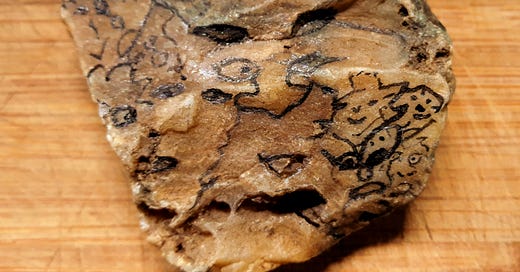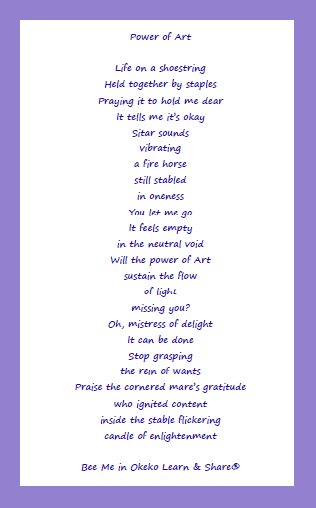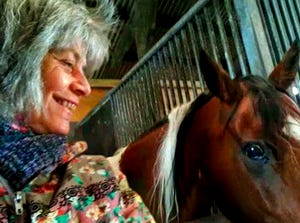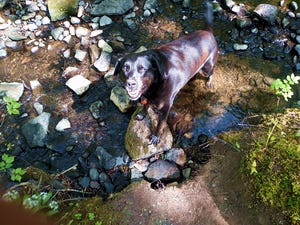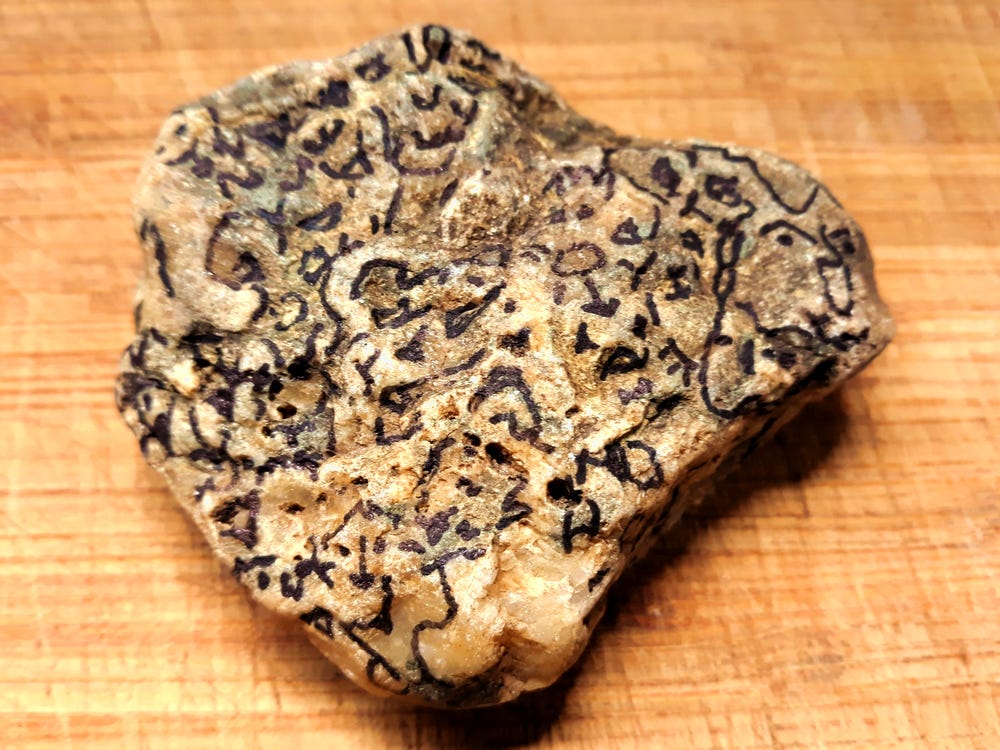Power of Art
Oh yes, I have the Astrological North Node in Taurus. I’m walking on a karmic pathway to innocence. Obviously I’m attracted to an enthusiastic biologist who writes about the reason why we don’t deeply realize our innocence so that we can “solve the human condition”. I love his bold statements, his considerable effort to educate and share for free. Although I don’t participate in the world-wide meetings of members of his organization or work towards a goal to “save the world” I appreciate his insights and courage to expose deceptive psychological dynamics playing in the background that hinder the flow of love.
His website www.HumanCondition.com provides a link to a free copy of his book ‘Freedom’. I’m talking about Jeremy Griffith and his World Transformation Movement. His organization sends me newsletters containing well written freedom-essays, the one I’m referring to is No. 44 titled ‘Art makes the invisible visible’ fell in my lap like a gift from heaven, perfectly timed to increase perspective in momentary dark, angry and lonely sentiments fuelling my motivation to express and share. A special moment because I’m in transition, creating a new identity by drawing stone spirits out that draw me in (it).
Oh for sure, I have an idea how that might sound to you; it doesn’t make sense to most of us… because our senses are misguided by a loop in ‘normal’ thought prevalent in the group-mind, which lead us astray, away from ‘our’ selves and its inherent emotional spiritual guidance. Using the power of Art facilitates healing. That’s the point I’m making here, if you will, and read on.
In July 2022, I watched an interview with Jeremy where he answers the question ‘what’s the meaning of man?’. He warms the viewer up by explaining that we prefer to defy our instincts when we feel the urge to expand consciousness, taking the fruits in the garden of Eden, so to speak, because this urge evokes emotion, often anger in our fellow man, and because most of us prefer to run away from the intensity of encounters with people around, unaware of the angst behind the anger, we hide our longing for inquiry, avoid contemplating the meaning of man, not realizing we thereby hide ‘our’-selves and disconnect from the universal flow of love and intelligence (that we are).
If you’ve read a few publications on my Substack, you’ll know this is right up my alley. Many times in life I processed my upsetting emotions when (best) friends and family members departed aggravated because they no longer were able to relate to me, and in Jeremy’s essay mentioned above he makes the case that people, particularly artists who expose “the true horror of our corruption, or some of the true beauty that exists on Earth” will do so “at great cost to themselves”. This cost, the pain exposed by horror or beauty has a connection to the need to be validated, the depth of innocence that longs reflection in the eyes of another human being.
As I said, I’m in transition, and although I’ve gone through many transits, welcoming change and manifesting shocks to my system, every transition wakes up the fears deep hidden in vaults that protect the lucid ‘me’ where nothing is to be found. I’m brave enough to deal with its content when the lid opens, if only a little. One result of a transition is always the same: friends depart. To me it seems that the courage to live-on, with or without support rocks the hidden vaults and that’s when lids flip open.
All kinds of things come out and happen. Fear of loneliness, the doubt creeps in. Was I right to defend myself when attacked? De-fend… now I see that I rattled the fences conveniently placed between my friends and I because I was not stopping at their fences any more.
Was it brave to stand up for myself when treated like a servant? Surely the maid in me disappeared. I didn’t feel this free for a long time. Overwhelmingly free. So free that I long to be treated again, but not like a slave or cruel of course. I would like to be treated for IT… the transition I mean. It’s like a child expecting a treat when it does good. Gem (my canine friend) does it all the time. It works.
I’m in the tension. The tension nobody around wants to be in. When friends leave, of course I miss them. I miss human contact. I can’t get angry at them, I’ve done that before and although it was part of my journey with many pearls in terms of what I learned from it, thank you very much, it’s a waste of energy because underneath the anger towards them, there is frustration and underneath that there is grief. The original pain in childhood of not being acknowledged as sincere, integer, lovable, intelligent, and innocent. The pressure to do ‘exactly as we always do’ is just too much in childhood to reject, but now, it is doable.
I was frustrated for a long period because nobody wanted to come along on my journey of (self) discovery with the aim to acknowledge the ‘me’ in all of us. Facing my desire to be validated, which was a whole journey in itself, and for which I’m preparing a separate post, was tough. It was like the rug was pulled underneath me, considering a 30-year ‘service mindset’ expressed in subsequent teacher, bodyworker and healer identities. Was I helping people to obscure my own pain? Was I secretly aiming to become powerful and famous, to be acknowledged? Yep, I found these bits in me, and it was not pleasant, because I’ve put a lot of effort in the save-guards that made it impossible for me to go for the power and fame, and when I went overboard, my integrity would’t stop nudging me, and life would shock my core so rigorously that my nervous-system would have to calibrate to my truth again.
But the tension doesn’t end there. There is a genuine need in all of us to be validated. I do get it that a lot of people tell themselves that this need, needs to be erased. It’s part of the spiritual bypass, so prevalent nowadays. Following this advice will also bypass the hurt. We had to get over our pain in order to survive childhood. We were not allowed to be IN pain (or in fear).
This desensitized us. We were forced to grow up without genuine validation and lost connection with ‘our’-selves. Lack of acknowledgement of our true nature, basically our innocence as mentioned before (that we are love and lovable in essence) was the cause of all our pain in childhood.
Jeremy says this makes us feel like aliens in our own bodies, harbouring guilt and anger, seeking retaliation, denying the ‘self’, and therefore become ego-driven and withdraw in what we call our shadow side (artificially reinforcing ourselves; longing to become fortunate in the ‘rat’ race instead of using our given powers) all of which he refers to as the human condition.
Furthermore, as a biologist Jeremy explains that the alien-in-our-body part originates from a split between our nerves and genes. Nerves need to understand cause and effect, but if people walk away from us, because of an unidentified reason, like it happened to me over and over again (very painfully so, before I knew this dynamic), our nerves don’t get informed of the reason why people walk away… the reason being that they prefer to stay where they are and fix themselves in a state where they can’t raise consciousness because they ignore emotions; they’re not ready to let love flow, be in flow, because it is too painful, they might go out of their minds, fearful to go mad, it might feel too lonely as well, etc. etc. etc.. So, most of us think it’s better to conform again to the initial training… don’t stick your head out. Stay where ‘we’ are.
Heaven forbid... to find out we are energy-beings in a cosmic bubble where energy flows in and out of our meat-suit!
So we nicely create a God-in-Heaven split off from ‘ME’ down here.
Yeah, that will do just fine ;)
Okay, back to Jeremy, and his view as a biologist on the split between nerves and genes. The genes orient our species, because hey, no matter how you look at it, life is about growth, change, doing business, having fun and enjoying the worldly pleasures. So here we see the tense parts in our bodies. We are driven by two urges, the need to be love and lovable on one hand and the need to grow, change and enjoy life in the inevitable rise of consciousness that starts when we acknowledge our true innocent nature.
That’s what I mean when I say ‘Be Me’.
Me as a subjective experience of It.
It = essence
According to Jeremy we therefore need psychological rehabilitation.
For me that means changing habits to restore natural live-on by training to stop doing what I always did. It is quite remarkable what happens next.
Okidoki, Let’s Make A Bridge To Art… And The Power Of It
When writing or drawing, a lot of focused energy goes in IT.
When people ignore it, it hurts the child inside, wanting attention, validation, discovery. Some say that this hurt is easily bypassed by realizing that the creative process is enjoyable and that artists should not work for such a childish result. I’ve heard people say that neediness is not okay.
I guess I find myself somewhere in the middle. Curious about the hurt, I realized I was an unseen child learning to see ME. That brought me to acknowledging the desire to be seen, but not so far that it dampens the joy of creating. So I have my emotions, looking forward to new subscribers, all the while on a side note, living-on a ‘desperate land’, surrounded by people’s unacknowledged despair doing their best to ignore their needs, especially the need for attention, validation, and the need to discover their innocence, their fundamental goodness. I’m-okay-you’re-okay kind of stuff.
Talking about the creative process, I also love to remark the synchronicity that takes place in me, for instance drawing something that is the exact picture of what I will write about much later, and ‘discovering’ the drawing again as if I never saw it before, or attracting situations that reflect the rumbling of emotions I wasn’t aware of. Or diving in the depth of a topic by writing about it and admiring a few days later a drawing made by an artist-friend that magically makes visible what I wrote, without us talking about it.
Oh yes, I process emotions, enjoy the creative process going in a flow, allowing my fingers to lightly press a keyboard or draw spirits out of a stone, and immerse myself in love for the end-result of inspiration, and then offer the results to ‘It’. Hoping, ‘it’ shakes others up to see It too, and ‘me’ eventually.
Artists tend to still have a child-like view. Their innocent wonder about beauty or seeing through the horror, where we
“recognize [...] the secret to what is going on in human life, namely an utterly escapist preoccupation with evasion and denial of the unbearably depressing issue of our human condition.”
The discrepancy between the efforts of an artist and the powers trying to rule the world could be seen as a manifestation of the tension in the split between nerves and genes, but also because of the growing amount of people becoming aware of the human condition, it exposes the disconnection between ‘It’ and ‘Me’ exploited by people still needing to overpower others in order to exert control and rule the world.
That’s what Jeremy highlights in his essay that I’ve mentioned before.
“Firstly, look at Bacon’s Study for self-portrait and Munch’s The Scream [[see the pictures in the essay]]. While in our day-to-day lives we block out the reality of the human condition, these paintings do expose the true nature of humans’ corrupted and alienated existence. Indeed, they depict what the Scottish psychiatrist R.D. Laing explicitly described when he wrote: ‘Our alienation goes to the roots… the ordinary person is a shrivelled, desiccated fragment of what a person can be… between us and It [our true selves or soul] there is a veil which is more like fifty feet of solid concrete’ (The Politics of Experience and The Bird of Paradise, 1967)”
The need to be seen and the longing for validation motivates to create, doesn’t it? We don’t have to reduce ourselves and dehydrate our being. We can allow the resolve of the “fifty feet of solid concrete between us and It”. Maybe I’m ‘right on time’ painting a picture of how it feels when people around can’t relate to me any more because I rattled not only my vaults, but theirs as well. The feeling of ‘alienation’ is part of it, both ways.
People are alienated from themselves because of the human condition (defying our instinct when we feel the urge to raise consciousness).
The artist, when not alienated from the ‘self’ (realizing ‘me’=IT) goes through a feeling of alienation when friends withdraw and walk away. They are not only dealing with the rejected need for human contact, but also the validation of their piece of art. Since the piece of art is a piece of ‘me’, the pain will open the lids of the inner vaults, I spoke of earlier, where we hide emotions, the feelings we were unable to feel in childhood, because the pressure to ‘do as we do’ is too intense to reject. No wonder, so many artists attack themselves, as we will see later, and not only among artists, the growing amount of people diagnosed with a wide variety of mental diseases certainly has a connection with the psychological loop of denial of our true nature.
As a former teacher, I’ve observed children ‘jump’ in tensed energy-fields and awkwardly express what adults don’t see and feel. They play for mirror… it’s part of innocence to take this risk, and make no sense, with the result that in another moment when enough people see IT, they don’t stop bathing it in honour, hand rubbing its shoulder, praising the lonely genius, if it is ‘lucky’ to be still alive. Van Gogh didn’t make it. It wrecked him.
“Great art ‘can make the invisible visible’; it can cut a window into our alienated, effectively dead state and bring back into view some of the beauty that our soul has access to. After years of developing his skills, Vincent van Gogh was able to bring out so much beauty that resigned humans looking at his paintings find themselves seeing light and colour as it really exists for possibly the first time in their life: ‘And after Van Gogh? Artists changed their ways of seeing…not for the myths, or the high prices, but for the way he opened their eyes’ (Bulletin mag. 30 Nov. 1993).” (See paragraph 829 of FREEDOM.)
[…]
BUT without the redeeming understanding of our corrupted, soul-repressed condition, what they were doing could be extremely confronting and hurtful for them. It can be understood then why artists who were too honest for their degree of soundness, artists who confronted the dark extent of the human condition and the sensitivities of our soul when it was more than they were capable of enduring, could take themselves to the brink of madness and/or suicidal depression. For example, of the six artists featured above, Van Gogh went over this brink and did suicide; Gauguin attempted suicide; Munch wrote that at one period of his life, ‘My condition was verging on madness—it was touch and go’ (Edvard Munch: Paintings, Sketches, and Studies, ed. Arne Eggum, 1984, p.236 of 305); Bacon led a tragically dissolute life, addicted to alcohol, sex and gambling; and in his later years Goya became so disillusioned by the world, he lived in near isolation doing his ‘Black Paintings’. Truly, while great artists let some relieving truth out, they could pay a huge personal price of having to live a torturous existence.
As I said, I’m not bypassing emotions that want to be felt. Or erasing the need to be in innocence, the need for attention to be seen innocent, the validation of ‘me’, seeing beauty all around but going through the horror of missing a reflection of ‘me’ in other people, the depth of innocence that longs reflection in the eyes of another human being, and nevertheless choosing to create, the effort of flowing in a creative process and presenting the pieces of ‘me’ resulting in the art of stone spirits. These are openings to my story as an unseen child. For people with the North Node in Taurus it is a theme in life to feel what could not be felt before in order to retrieve the lost innocence from bonds to alienated people with “fifty feet of solid concrete between us and It”.
Minding my business comes to mind, which is a can of worms in itself. Why would I listen to people who say that the need for validation is not okay? Is it maybe an attempt to convince me to stay in my cage? Not bother about ‘me’? I still remember a conversation almost 40 years ago with one of the lecturers in my teacher training. He asked me why I found it so important to gain high marks. Well, it is a validation, isn’t it? The reward for efforts. So, I asked him if he would still show up in the academy, when his boss would pay him considerably less salary…. He only laughed.
Of course, I take care of my validation needs. It happens in me. It’s part of the transition process, glad without the distraction of friends who can’t see ‘me’.
They let me go
It lets you go
Now I’m free to see/feel me.
There’s a difference, but also a connection between filling a void and wanting reward for effort.
Minding my business opens the way for people like me, who also see/feel ‘me’., allowing the pieces of ME to be appreciated is beneficial for me and the viewer which is part of validation. Perhaps the sentence at the beginning of this publication: ‘I am creating a new identity by drawing stone spirits out that draw me (and you) in (It)’ makes more sense now. Viewing art heals, that’s the hidden power behind it. It has the power to go through the “fifty feet of solid concrete between us and It”.
Besides that, it’s lovely to draw, it calms me, even freeing me. Sometimes I’m so entrenched that I forget everything around me, even Gem. All attention goes in IT, what Jeremy calls our true selves or soul, therefore I’m creating an opportunity for you to be drawn in IT, reconnecting ‘the ME’ in all of us... in IT.
Would you like to dive into a topic like this?
Part of my busyness here is to organize Okeko Learn & Share Gatherings for my Substack Subscribers. So why not subscribe first (and validate ‘me’ ;)
Let’s do it!
PS
“[In] his Study for self-portrait (above left [in Jeremy’s essay]). It is some recognition of the incredible integrity/honesty of Bacon’s work that in 2013 one of his triptychs sold for $US142.4 million, becoming (at the time) ‘the most expensive work of art ever sold at auction, breaking the previous record, set in May 2012, when a version of Munch’s ‘The Scream’ [another exceptionally honest, human-condition-revealing painting shown above on the right] sold for $119.9 million’ (TIME, 25 Nov. 2013).” (See paragraphs 124–125 of FREEDOM — you can also read more about Bacon’s work in various F. Essays including 31, 42 & 55.)

